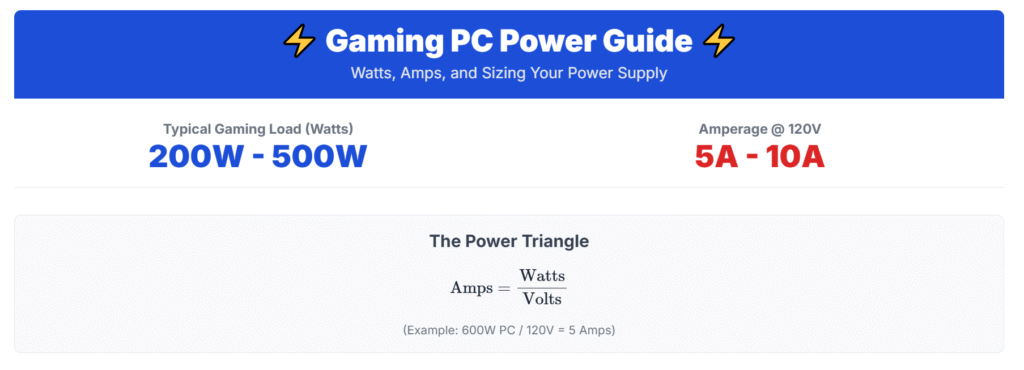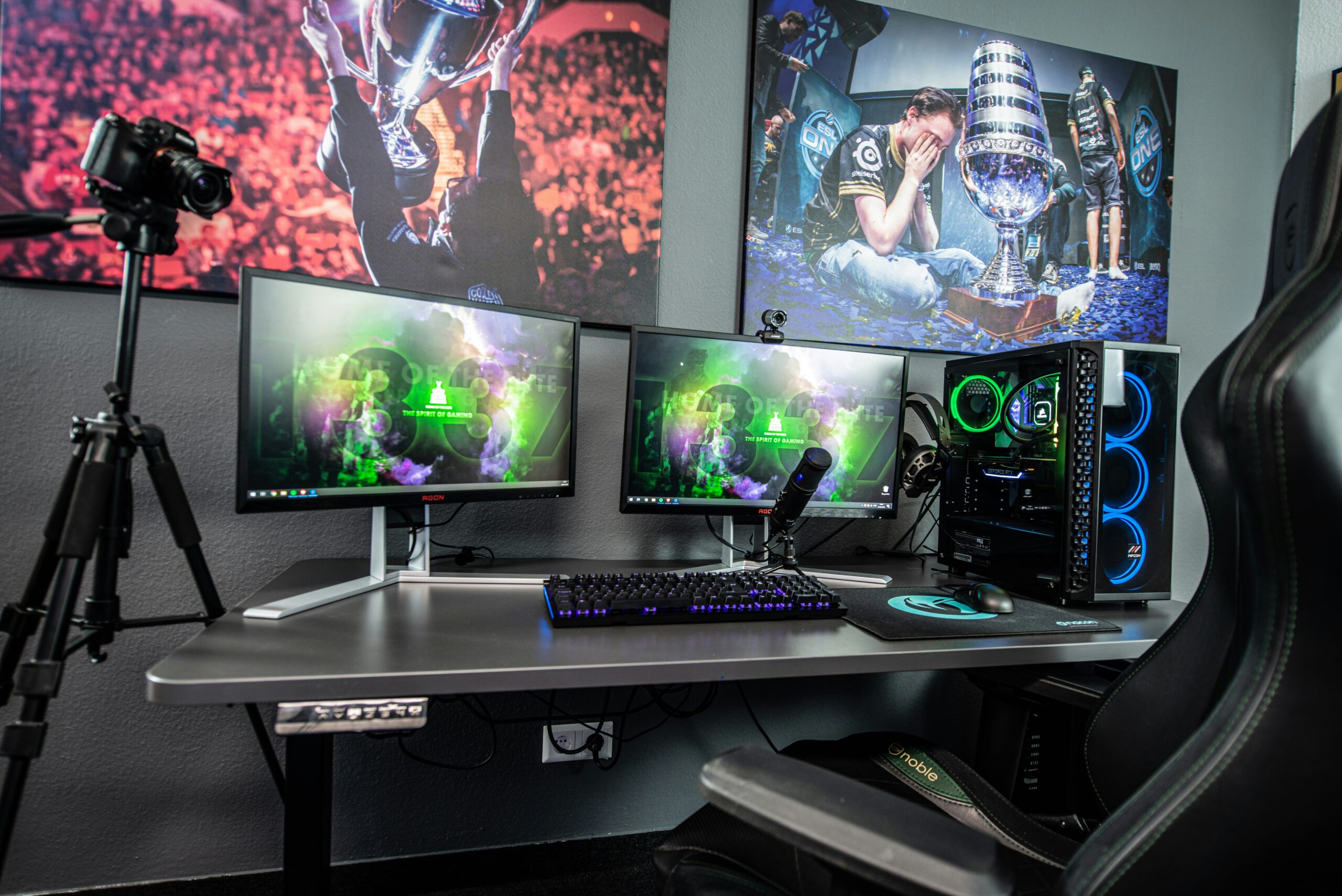A typical gaming PC uses between 200 and 500 watts of power, translating roughly to 5 to 10 amps in a standard 120V household circuit, but high-end enthusiast systems can easily exceed 700 watts under full load.

The Short Answer: Gaming PC Wattage and Amperage Explained
A typical gaming PC draws about 200 – 500 watts (≈ 5–10 amps at 120 V), but high-end systems can exceed 700 watts under full load. And when you add monitors, external drives, lighting, USB devices, and other peripherals, the total draw can climb even higher.
This range accounts for most mid-range systems running popular titles. However, the exact power draw, and consequently the amps of a gaming PC, depends entirely on the components inside, particularly the graphics card and the CPU, and what those components are being asked to do.
While testing various configurations over the years, I’ve seen this range shift dramatically. A budget eSports rig might hover closer to 200W, while a high-resolution, max-settings machine will push toward the 500W mark, sometimes much higher.
This difference is why understanding your specific components is crucial for choosing the right Power Supply Unit (PSU) and preventing problems like tripped breakers.
Decoding Wattage, Amperage, and Voltage
Before we dive into the specific numbers, it’s helpful to quickly recap the relationship between the three main terms: Watts, Amps, and Volts.
- Watts (W): This is the measure of power—the rate at which energy is consumed or produced. When you ask about gaming PC wattage, you are asking for the total energy consumed per second. This is the figure most critical for PSU selection.
- Amps (A): This is the measure of current—the volume or flow rate of electrical charge. When your PC is plugged into a wall outlet, the total amperage determines how much load is placed on your house’s electrical circuit.
- Volts (V): This is the measure of potential difference—the electrical pressure that drives the current. In North America, standard household voltage is typically 110V-120V; in most other regions (Europe, Asia, etc.), it is 220V-240V.
The relationship is defined by the formula: Watts = Volts x Amps.
Therefore, the amperage drawn by your PC from the wall socket can be calculated using the formula I always recommend to people: Amps = Watts / Volts.
For example, a 600W PC on a 120V circuit draws about 5 Amps, which aligns perfectly with the fact that a typical gaming PC draws 5 to 10 amps depending on specifications.
The Power Hogs: Components That Drive Gaming PC Wattage
When considering “how many watts does a PC use,” you must recognize that not all parts contribute equally to the overall draw.
Based on my professional experience of reviewing PCs, the Graphics Processing Unit (GPU) and the Central Processing Unit (CPU) are the undisputed champions of power consumption.
Graphics Card (GPU): The Power Beast
The GPU is, without a doubt, the most power-hungry component in a gaming PC. It’s responsible for rendering the complex 3D worlds and high-resolution textures that gamers demand.
Mid-Range GPUs: Often consume ~150-250 W, while High-End/Flagship GPUs: Easily consume ~350-600 W or more.
It’s the first component I check when calculating total gaming PC wattage. You simply cannot underestimate the power requirements of a cutting-edge graphics card.
Central Processing Unit (CPU): The Next Big Consumer
While the GPU is generally more power-hungry than the CPU, modern multi-core Intel “K” and AMD “X” series CPUs can draw 200-300 W or more under heavy all-core turbo or multi-threaded workloads.
For example, many “K” class CPUs show base powers around ~125 W, but under turbo (PL2 / MTP) pull closer to 240-260 W, depending on workload and cooling.
In extreme workstation / HEDT chips (like AMD Threadripper), full load power draws in the 300-400 W range are not uncommon
High-end CPUs can consume anywhere from to over
, especially when overclocked. This is another major factor in determining the total amps of a gaming PC.
Other Components and Their Draw
The remaining parts of your system add up, but their individual power consumption is significantly lower than the CPU or GPU:
| Component | Typical Wattage Draw (Approximate) | Notes |
| Graphics Card (GPU) | 110W – 450W+ | Depends heavily on model and load (the highest draw) |
| Central Processor (CPU) | 55W – 250W+ | Varies with core count, clock speed, and load |
| Motherboard | 25W – 100W | Includes chipset and basic circuits |
| RAM (Memory) | 2W – 10W per stick | Very low relative draw |
| Storage (SSD/HDD) | 1W – 15W per drive | SSDs are typically lower than HDDs |
| Case Fans (Per Fan) | 1W – 5W | Negligible, but adds up with many fans |
| Peripherals (via USB) | 5W – 20W total | Keyboards, mice, webcams, etc. |
Enthusiast Systems: When Wattage Skyrockets
For those building what I call “enthusiast rigs” or multi-GPU systems, PCs designed for extreme performance, 4K/8K gaming, or professional rendering—the power demands are drastically higher.
As the verified data suggests, high-performance/enthusiast rigs and multi-GPU systems may exceed 700–1000 watts under full load.
If you decide to run two top-tier GPUs (a rarity now, but possible) or run a high-core count CPU combined with a flagship GPU, you absolutely must factor in the possibility of a total system draw of or more.
This is why you see massive 1200W or even 1600W PSUs on the market—they are specifically designed to handle these power-hungry, high-performance beasts.
The Power Supply Unit (PSU) and Headroom
Choosing the right PSU is perhaps the single most important step in calculating and managing your power consumption. The PSU doesn’t consume the power; it converts and delivers it. A common misconception is that a 1000W PSU will always draw 1000W—it only draws what the components require.
A best practice I’ve adopted from years of building systems is to always incorporate a safety buffer. PSUs are usually built with ~40% extra headroom above the expected system draw to prevent overloading.
Why the Headroom?
- Efficiency: PSUs are most efficient (i.e., waste the least power as heat) when running at about 50-70% of their maximum capacity.
- Transients: Components, especially the GPU, can have momentary, very high power spikes (transients) that last milliseconds. Headroom ensures the PSU can handle these spikes without shutting down.
- Future Proofing: Headroom allows for future component upgrades without needing to replace the PSU immediately.
For example, if your estimated total system draw is 500W, a good PSU choice would be (for 40% headroom)
. Therefore, a quality 750W or 850W unit would be an ideal choice, giving you ample safety margin and optimal efficiency.
Step-by-Step Guide: How to Calculate Your Gaming PC’s Wattage and Amperage
If you want to know the true power draw of your specific system, follow this guide to calculate both the gaming PC wattage and the resulting amperage.
Step 1: List Core Component Wattage
Goal: Identify the maximum potential draw for your CPU and GPU.
- Look up the Thermal Design Power (TDP) or, better yet, the Maximum Power Consumption for your specific CPU model on the manufacturer’s website (e.g., Intel ARK or AMD product pages).
- Look up the Total Board Power (TBP) or TDP for your specific GPU model. This is your highest-consuming component.
Step 2: Estimate Remaining Component Draw
Goal: Add a reasonable estimate for the rest of the system, including the motherboard, RAM, storage, and fans.
- Motherboard/Chipset: Add 50W.
- RAM (4 sticks): Add 20W.
- Storage (2 SSDs/HDDs): Add 20W.
- Fans/LEDs/Peripherals: Add 20W.
- Total for Rest of System (C): 110W (Use this value for an easy, safe estimate).
Step 3: Calculate Estimated Total System Wattage
Goal: Sum the values to find your maximum realistic power draw under load.
Step 4: Determine Required PSU Wattage (Headroom)
Goal: Apply the recommended safety buffer.
- Required PSU Wattage =
(40% Headroom)
Step 5: Calculate Amperage Draw from the Wall
Goal: Use the Amps = Watts /Volts formula.
- Use your Maximum System Wattage () from Step 3 for the most accurate measure of wall draw.
- Use your local household voltage (typically 120V in North America, 230V elsewhere).

Sample Build Power Consumption Table
To give you a real-world perspective on “how many watts does a PC use,” here are three common scenarios:
| Build Scenario | CPU | GPU | Estimated Total Wattage (Load) | Recommended PSU (with 40% Headroom) | Amps @ 120V |
| 1. Entry-Level eSports | Core i3/Ryzen 3 | GTX 1660/RTX 3050 | 450W – 550W | ||
| 2. Mid-Range 1440p Gaming | Core i5/Ryzen 5 | RTX 4070/RX 7700 XT | 650W – 750W | ||
| 3. High-End 4K Enthusiast | Core i9/Ryzen 9 | RTX 4090/RX 7900 XTX | 1000W – 1200W |
Frequently Asked Questions (FAQ)
How many watts does a standard gaming PC use on average?
A standard, modern gaming PC typically uses between 200 and 500 watts when actively running a demanding game, but this figure can spike higher during intense scenes or benchmarks. This is the range most builders aim for when calculating their total gaming PC wattage.
Is a 650W PSU enough for a modern gaming PC?
In my opinion, a high-quality 650W PSU is sufficient for most mid-range gaming PCs that pair a Core i5/Ryzen 5 CPU with a mid-to-high-end GPU like an RTX 4070, but for flagship GPUs or highly overclocked systems, you will need to step up to at least 750W or more.
Always calculate your component draw first.
How many amps does a gaming PC draw from the wall socket?
A typical gaming PC draws somewhere in the range of 5 to 10 amps from a standard 120V wall socket, which is determined by dividing the system’s maximum wattage by the voltage (Amps = Watts /Volts).
This is well within the limits of a standard household 15-amp circuit, but remember to factor in other devices plugged into the same circuit.
Do all components consume their maximum wattage all the time?
No, components rarely consume their maximum listed wattage (TDP) constantly. The maximum draw is only reached under synthetic stress tests or peak gaming loads. When your PC is idling or just browsing the web, the power consumption, and thus the overall amps of the gaming PC.
How does PSU efficiency affect the power drawn from the wall?
PSU efficiency ratings (like 80 PLUS Bronze, Gold, or Platinum) indicate how much AC power from the wall is successfully converted into DC power for the components.
While testing, I discovered that a higher efficiency rating means less power is wasted as heat, which translates directly to less power being drawn from the wall to achieve the same component output.
For example, a system requiring 500W will pull more from the wall with a Bronze PSU than with a Platinum one.
Summary and Final Thoughts
The exact answer to “how many amps/watts does a gaming PC use” is inherently variable, but the core principle remains consistent: the GPU dictates the majority of the power draw.
While most systems fall into the 200W to 500W range, enthusiasts must be aware that their high-performance/enthusiast rigs can easily go over 700W and require substantial power supplies.
For a reliable, future-proof system, always calculate your maximum component draw, and then select a PSU that gives you at least a 40% extra headroom above that number. This practice ensures maximum stability, efficiency, and longevity for your gaming PC.

